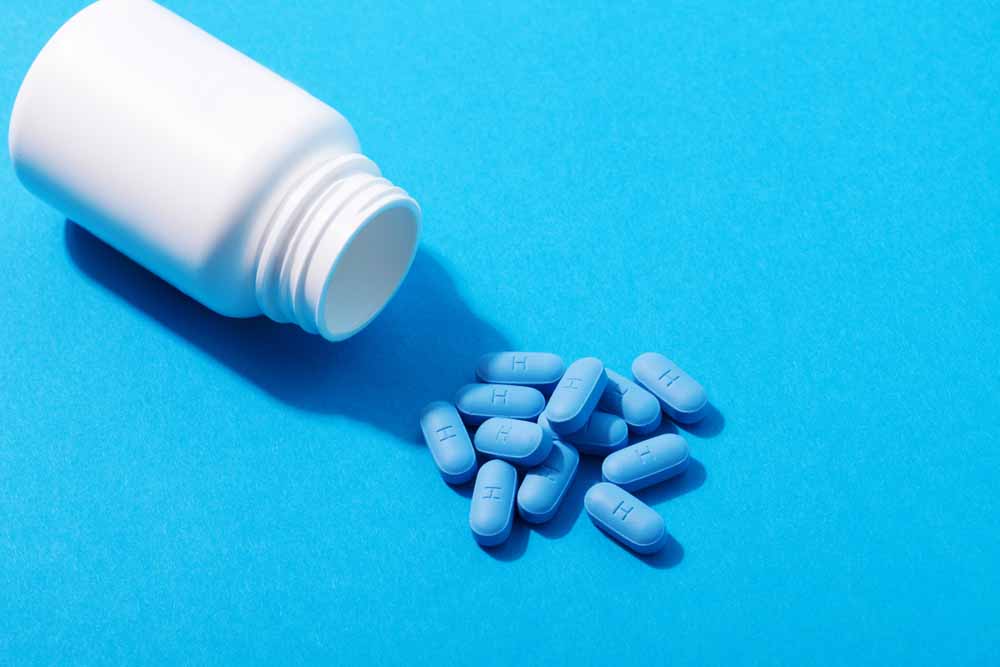Several behavioural and biomedical strategies already exist to prevent new human immunodeficiency virus (HIV) infection and transmission, from condoms to antiretroviral therapy for HIV-positive persons, and pre- and post- exposure prophylaxis for HIV-uninfected persons.
One of the most effective ways today to prevent transmission from an infected to an uninfected person is the attainment of viral suppression in HIV-positive persons.
Two prospective observational studies in 14 European countries, PARTNER1 and PARTNER2, followed heterosexual and gay serodifferent couples who reported engaging in condomless sex where the HIV-positive partner was using suppressive antiretroviral therapy (ART). The serodifferent heterosexual couples were followed from 2010 to 2014 and the serodifferent gay couples from 2010 to 2017. The findings in both studies was an HIV transmission rate of zero (upper 95% CI; 0.23 per 100 couple-years of follow-up) if the HIV-positive partner was virally suppressed (defined as plasma HIV-1 RNA <200 copies per mL).1, 2 These findings support the National Institutes of Health promotion of U=U (undetectable equals untransmittable).
According to The Joint United Nations Programme of HIV/AIDS (UNAIDS), new HIV cases continue to emerge worldwide. In 2017, 1.8 million and in 2018, an additional 1.7 million new infections were acquired. UNAIDS differentiates between infections acquired and infections diagnosed, and estimates that about 21% of those who have HIV have not been diagnosed, and up to half of those diagnosed with HIV are not receiving ART. In addition, of those who are receiving ART, less than half remain virally suppressed three years after starting treatment. This means a large group of people are currently capable of transmitting HIV to uninfected persons. Given this, and that an effective vaccine to prevent HIV transmission is still many years away, a range of HIV prevention strategies still need to be explored. This paper will discuss pre- exposure prophylaxis (PrEP) as an HIV infection prevention strategy and will outline some underwriting considerations for an applicant taking PrEP.
Pre-Exposure Prophylaxis (PrEP) Defined
PrEP is an HIV prevention strategy in which antiretroviral medications are used by HIV- uninfected individuals at high risk of infection to prevent its acquisition. In 2012, the Food and Drug Administration (FDA) (U.S.) approved the combined regime of tenofovir disoproxil fumarate and emtricitabine (TDF-FTC) for PrEP. Since then, PrEP has become a well-utilized strategy: A 2018 study showed that the number of PrEP users in 2017 in the U.S. alone increased to 100,282 from 8,768 in 2012.3 Unfortunately, this number represents only a fraction of the estimated 1.1 million persons in the U.S. who have indications to take PrEP.4
The single fixed-dose tablet combination of TDF (300 mg) and FTC (200 mg) is to be taken orally on a daily basis for as long as the uninfected person remains at high risk of acquiring HIV. Persons at high risk include men who have sex with men (MSM) and heterosexual men and women who have multiple sex partners and inconsistent condom use. It is not recommended for persons who consistently engage in low risk sexual behaviours; i.e., who consistently use a condom when engaging in anal or vaginal intercourse and/or experience no mucosal exposure to genital secretions. PrEP is also indicated for an HIV-negative person engaging in condomless sex with an HIV-positive person unless the infected partner has been on antiretroviral therapy (ART) for at least six months and is virally suppressed (i.e., has a plasma viral load of <200 copies per mL).
Potential Risks of PrEP
Persons wishing to start TDF-FTC PrEP should be assessed before starting the therapy for HIV infection status (undiagnosed or acute), abnormal renal function, chronic hepatitis B infection (HBV), osteoporosis, and pregnancy.
An acute or undiagnosed established HIV infection needs to be ruled out prior to starting PrEP. If testing confirms an HIV infection, the individual should be treated with a combination antiretroviral regime, as the use of TDF-FTC as PrEP in an HIV-positive individual leads to the rapid development of resistance to FTC.5
TDF-FTC is also contraindicated in persons with a creatinine clearance of <60 mL/min due to the risk of nephrotoxicity. In addition, during the first six months of PrEP therapy TDF can lead to a reduction in bone density, but it stabilizes after that.6
Protocols for Prescribing and Use
TDF-FTC should initially be prescribed for 90 days and refilled only after testing for current HIV status,8 sexually transmitted infection (STI) status,9 and renal function. After this initial three-month period, the individual should continue to be monitored every three months, and only receive additional 90-day supplies after testing. PrEP adherence and risk behaviours should be discussed during the three-month follow-up visits regardless of symptoms.
In persons without risk factors for renal disease, a serum creatinine level should be taken every six months, and for those with renal disease risk factors (e.g., hypertension, diabetes, proteinuria, older age, prior history of renal insufficiency), a serum creatinine level should be taken every three months and a urinalysis performed every six months.
Ideally, PrEP users should continue condom use. This will reduce their risk of acquiring STIs and the hepatitis C virus10 as well as protect against HIV infection until appropriate intracellular levels of TDF are achieved. How long condoms need to be used varies, but generally it is recommended for seven days after starting PrEP for patients engaging in receptive anal sex and 21 days after starting PrEP for patients engaging in receptive vaginal sex.8
The reality is that most people taking PrEP continue to engage in high-risk sexual behaviours, especially not using a condom. Studies of MSM who take PrEP have shown that approximately 30% to 50% were subsequently diagnosed with a bacterial STI. A recent systematic review showed that PrEP use was associated with a significant increase in rectal chlamydia (odds ratio [OR] 1.59; 95% confidence interval [CI] [1.19-2.13]) and an increase in any STI diagnosis (OR 1.24; 95% CI [0.99-1.54]). In addition, association of PrEP use with STI diagnoses was stronger in later studies: Most studies showed evidence of an increase in condomless sex among PrEP users.11
Although it would appear that PrEP use may increase high-risk behaviours, the risk of HIV infection remains low as long as the uninfected person continues on PrEP. This was clearly seen in one study that followed 657 men for seven months. During this period, 30% of the men were diagnosed with a least one STI, but no new cases of HIV were diagnosed.12 This finding highlights the importance of frequent STI testing for persons on PrEP.
Intermittent (or on-demand) PrEP regimens for persons not wanting to take daily medication and who can predict when they will have condomless sex have not been studied extensively; as a result, long-term outcomes for this cohort are difficult to predict. One on-demand (event-driven) regimen indicates two TDF-FTC tablets to be taken two to 24 hours prior to sexual activity, then one tablet taken daily while the individual is sexually active and continued for two more days after sexual activity has stopped. For individuals who initiate on-demand PrEP more than once within a week, the loading dose should be reduced to one tablet.13
Due to a lack of adequate studies, on-demand PrEP usage is not yet approved in the U.S. by the FDA. However, it has been approved in France and is being offered in a number of PrEP demonstration projects in Europe, but only for high-risk MSM populations.
New Directions
Alternative forms of PrEP delivery, such as a vaginal gel and a vaginal ring, as well as alternative PrEP formulations, are also being investigated. One such formulation combines tenofovir alafenamide (TAF) with FTC.
A recent study of TAF-FTC in more than 5,000 high-risk MSM and transgender women (male to female) found that its efficacy in preventing HIV infection was at least comparable to that of TDF-FTC.14 The advantage of this alternate formulation is fewer bone and renal issues than with TDF-FTC. At present, TAF-FTC is pending approval from the FDA for use as PrEP. Until then, the recommendation is to continue to use TDF-FTC for PrEP.
Efficacy
A recent review published in the Journal of the American Medical Association7 summarized the observations of four placebo-controlled randomized clinical trials of PrEP use consisting of daily doses of TDF- FTC. The findings were:
- TDF-FTC significantly reduces HIV acquisition in MSM populations, high-risk heterosexuals, and injection drug users who share needles
- Daily TDF-FTC efficacy exceeds 90% but is highly correlated with degree of adherence
- Only 2% discontinue PrEP because of adverse effects (nausea and vomiting), hence it can be considered safe and well-tolerated
- STIs are common among those using PrEP
- Resistance to TDF-FTC when used for PrEP is rare (<0.1%) and usually occurs when inadvertently prescribed to individuals with undiagnosed acute HIV infection who have false-negative findings on HIV antibody/antigen testing due to HIV infection acquired within seven to ten days of testing
Overall, the data strongly support that PrEP is effective and safe in preventing HIV infection in HIV-negative persons at high risk, but as mentioned at the start of this article, its usage is low. There are a number of reasons for this, which include lack of health provider and consumer knowledge, mistrust of the medical system, and the potential stigma. Additional barriers to PrEP use can also include the high cost of the medication and the quarterly office visits and associated laboratory testing. The average total cost of PrEP in the U.S. is estimated to be more than $10,000 per year.15 Despite this cost, PrEP has been shown to be very cost-effective in high-risk persons.15
Risk Stratification
A proposed insured who is taking PrEP should be underwritten in the same manner as any other person taking a medication to prevent the development of certain diseases. PrEP may also be seen as similar to vaccinations, which are given on a pre-exposure prophylaxis basis to reduce a person’s risk of infection and enhance public health. To take adverse action on a life insurance application solely due to use of PrEP may go against the public health or regulatory policy of the country in which the policy is being underwritten and may be without scientific merit. That being said, risk behaviors and other indications for the use of PrEP, such as intravenous drug use, should be considered during the underwriting process.
Conclusion
While there is yet no vaccine for the successful prevention of HIV, effective prevention strategies are available. Treatment as prevention and now PrEP are proving their value in the global fight to control and eliminate the transmission of HIV. Insurers need to understand the research with regard to PrEP, and ensure that underwriting policies are up to date, appropriate, and compliant with regulations.



